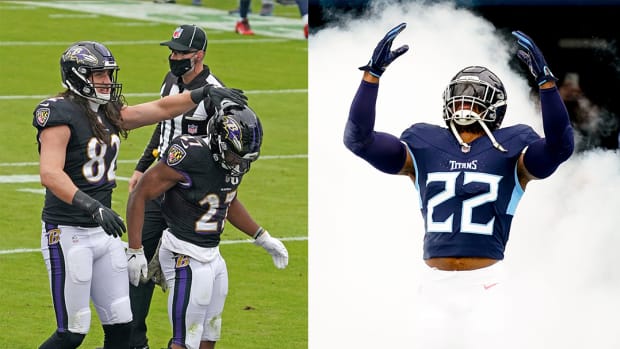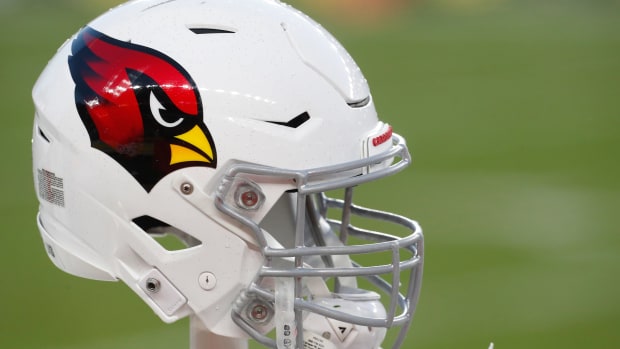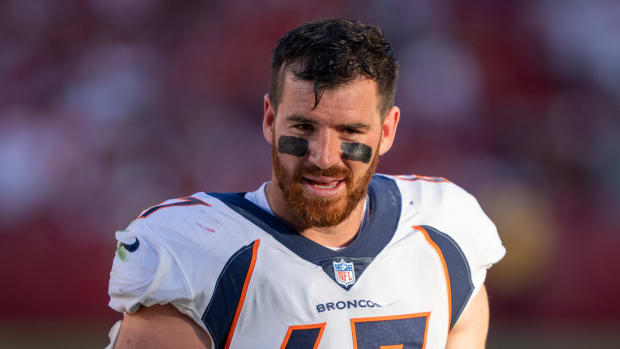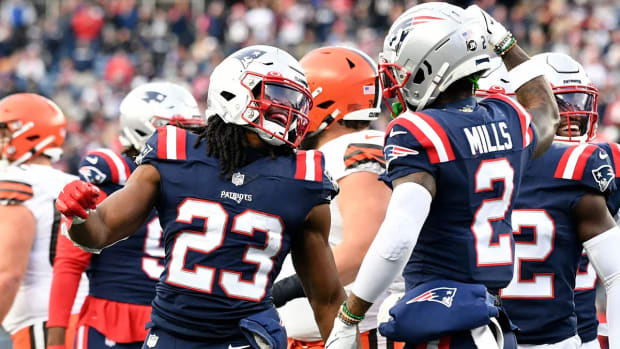Handsome Is As Handsome Does: Are QBs really the best-looking players?
In their new book This is Your Brain on Sports, L. Jon Wertheim and Sam Sommers challenge conventional wisdom, uncover the hidden influences in sports and use reams of data to investigate questions that tug at every fan. Why are rivalries so important? What’s the appeal of the T-shirt cannon? Why do hockey goons win more fights in their home arena?
In the following excerpt, which also appears in the Feb. 8, 2016 issue of Sports Illustrated, the authors—one a writer at SI, the other a Tufts psychology professor—explore the myth of the good-looking quarterback.Subscribe to the magazine here.
It’s a long-standing article of faith: We like our quarterbacks handsome. The storied lineage spans from Broadway Joe Namath to Joe Montana to Brett Favre to Tom Brady, Aaron Rodgers and Russell Wilson. The polarizing, short-lived cult of Tim Tebow? Even his biggest detractors must concede: not the worst-looking guy. The attractiveness of Texas Tech coach Kliff Kingsbury is an Internet meme. (HOT KLIFF KINGSBURY FLIRTS WITH MOMS OF RECRUITS.) Naturally, Hot Kliff Kingsbury is a former college quarterback.
Pop culture has cemented this image. Name a Hollywood leading man (Burt Reynolds, Kurt Russell, Warren Beatty, Keanu Reeves, Dennis Quaid, Jamie Foxx) and odds are good he has played a quarterback. There are examples of the reverse too. Before he was special agent Leroy Jethro Gibbs on NCIS, Mark Harmon was a quarterback at UCLA.
In fact, the allure of being an alluring QB can motivate a position change. Brad Grayson, father of the Saints’ Garrett Grayson, said his son’s decision several years ago to switch from running back to quarterback was calculated. “Gotta consider the ladies,” Brad explained with a smile.
The inevitable question, then: Why are quarterbacks so damned good-looking?

Quarterbacks included in this week’s cover, from top to bottom: Aaron Rodgers, Tom Brady, Cam Newton, Peyton Manning, Tony Romo, Ben Roethlisberger.
As he tends to do, radio host Colin Cowherd offers a theory based less on specific research than on a need to play provocateur. “When boys growing up are picking teams and positions,” Cowherd once said, “they always pick a good-looking kid to be quarterback. That . . . sets up the pattern.” In other words, the best-looking kids in the schoolyard are selected for the glamour position. They are put on a quarterback track, and by the time they begin playing organized football, they are experienced at the position. It’s a self-fulfilling prophecy.
That makes sense—until we pose the hypothesis to Brady, perhaps the fairest quarterback in the land. A sandlot Casanova, he was conferred the quarterback position at an early age, right? Um, not so much. “I played football for the first time in high school,” Brady said. “They didn’t have much Pop Warner where I grew up. I was actually a much better baseball player. By junior year I started to grow into my body. I always could throw the ball really [well]. We tried to improve my athleticism. We did a lot of 6 a.m. workouts. Rope courses. Dot drills. I was always the slowest kid in high school. I was the slowest kid in college. I’m still [slow].”
There’s a corollary to Cowherd’s theory that goes like this: The best-looking kids gravitate to quarterbacking because it’s the most glamorous position. When we posed this to another line-of-scrimmage Lothario, we had to cover our ears to mute the deep, familiar laughter on the other end of the line. “I never considered myself good-looking,” said Namath, a man once described by Playboy as a kind of Belmondo with a jockstrap. “My hair, my teeth. Don’t get me started! Trust me, kids want to play quarterback, but it has nothing to do with their looks.”
How did Namath become a quarterback, anyway? “I was one of the smaller kids, but could always throw fairly well,” he said. “I played some football but was more into basketball. My freshman year, the first-string quarterback broke his arm. So in I went. But in 10th grade I was fifth or sixth on the depth chart and didn’t even get invited to camp. I told the coach I wanted to quit: ‘I’m gonna play baseball.’ He asked me to stay. Fine.
“I spent a season carrying tackling dummies. Then, between my sophomore and junior years, I hit a growth spurt and got to six feet. I started four games, but I had fumbles and missed receivers and got replaced by Rich Niedbala, who went on to play at Miami. It wasn’t until senior year that I really got to be the quarterback. So, long story short: None of this had to do with looks.”
Still cackling, Namath added: “Let me tell you one more thing about quarterbacks: They don’t look nearly as good when they’re losing.”
When we asked NFL players at other positions to address the alleged pulchritude of the passer, we found limited support for the notion. “I can see that being kind of true,” said Greg Olsen, the Panthers’ tight end. “People are drawn to good-looking people. Maybe they would be more likely to follow or rally around a good-looking person.” But far more non-QBs were skeptical.
“The television camera is trained to focus on the quarterback, so that’s who fans see,” said London Fletcher, a Pro Bowl linebacker who played in the NFL from 1998 to 2013. “Trust me, [players] at other positions, we’re just as good-looking.”
Larry Fitzgerald, maybe the best NFL wide receiver over the last decade, took similar umbrage. “For every good-looking [quarterback],” he told us, “I can think of one who’s not so good-looking.”
These varied responses got us thinking: Before explaining why quarterbacks are so damned good-looking, maybe we should ask, Are quarterbacks so damned good-looking?
It turns out there’s more than one way for researchers to measure attractiveness. Consider a study conducted by a team of U.S. and British economists a few years ago. They were interested in how a quarterback’s physical appearance affected his salary. So they assessed the attractiveness of 138 active and former NFL QBs using computer software that calculated the facial symmetry in each player’s official media photo. (Facial symmetry usually predicts perceptions of attractiveness. The evolutionary explanation is that symmetry tends to indicate health and reproductive fitness, marking someone as a desirable mate. High symmetry? Think George Clooney. Low symmetry? Google Lyle Lovett.)
• Can you determine an athlete’s leadership qualities using only a photo?
By this measure, the economists reported, Matt Ryan of the Falcons led all active quarterbacks. More interesting, the researchers found that the more symmetrical a QB’s face was, the more money he made. These findings are consistent with results in domains outside of sports. Attractive employees tend to earn more than their less attractive colleagues in a variety of professions.
“Socially, we’ve been trained to think that the quarterback is the most beautiful person on the team,” Jennifer Van Gilder, one of the study’s authors, told The Wall Street Journal.
But this study didn’t test whether QBs are more attractive than other football players. So, are they?
Cam Newton’s father reflects on his son’s season of ‘Cam being Cam’
Intrigued as we were by the computer-based measure of facial symmetry, we decided to go old-school in evaluating attractiveness. Like researchers before us, we compiled official media photos of NFL quarterbacks, but then we simply asked respondents to rate the attractiveness of each face. We used a rating scale of 1 to 10 (10, of course, being the quintessence of beauty). For our first survey, we used photos of all 32 NFL signal-callers who opened the 2014 season as their team’s starter (QB1). Each photo was cropped at the neck so no team uniform was visible: We wanted our raters to be unaware that they were looking at NFL players, much less quarterbacks.
Next, we needed other position groups for comparison. We settled on wide receivers and defensive backs, ruling out other positions because of body type. Linemen are too bulky; kickers and punters, too scrawny. We also factored in ethnicity. About 75% of the NFL’s starting QBs over the past decade have been white, so we held this demographic rate constant across all our positions. To do this, we randomly selected one white and one nonwhite wide receiver and defensive back from as many teams as possible. (Some teams didn’t have, for example, a white WR.) Then we randomly selected players from that pool until we had one comparison group of wide receivers and one of defensive backs that were 75% white and 25% nonwhite. We cropped their photos the same way as the QBs’ shots.
Finally we recruited 100 people online to rate, using the 1-to-10 scale, players whose photos we presented in random order. Again, we didn’t tell the raters that these were football players. Then we ran the study again, recruiting 100 new raters (and swapping in linebackers for defensive backs).
Who was the fairest of them all, according to our superficial ratings? Among quarterbacks, the Chiefs’ Alex Smith took the top spot, followed by Brady and the Dolphins’ Ryan Tannehill. But what about the positional comparison? Just how much more attractive were QBs than other players? The answer in our first sample of 100 respondents: not a bit. In fact, quarterbacks received the lowest ratings of the three positions: 4.5, compared with 4.7 for wide receivers and 5.0 for defensive backs.
When we ran the study again, with a fresh set of 100 raters? Same finding. Quarterbacks came in last, behind wide receivers and linebackers.
Wait—what? Quarterbacks are less attractive than wide receivers and defensive players? This wasn’t what we expected. So we collected yet more data. We shifted to college football. We picked 20 Division I schools at random, and for each one located a starting quarterback, wide receiver and defensive back, again holding constant the racial demographics of 75% white and 25% nonwhite. Then we ran the same study with their photos. Guess what? College QBs were rated third out of the three positions.
Media Night Snaps: Wade Phillips’s chance at magical finish he deserves
In no study that we ran did we find any evidence that quarterbacks are more attractive than players at other positions, no matter how we sliced the data: not among male raters and not among female raters; not among big NFL fans and not among those who know Aaron Rodgers only as the Discount Double-Check Guy. Quarterbacks came in dead last every time.
So back to our original question: Why are quarterbacks so damned good looking? Apparently they’re not. We just assume they are. Van Gilder, the economist, nailed it when she said that socially, we’ve been trained to think that the quarterback is the most beautiful person on the team.
Why is this? In large part it’s because when we form impressions of people, our global assessments alter the ways in which we perceive their specific characteristics, as demonstrated in a study conducted several years ago by Dick Nisbett and Tim Wilson.
The two psychologists told students at the University of Michigan that they would be watching a video interview with a professor and then answering questions about him. But there were two versions of the video. In the first, the professor was warm and personable, and he expressed enthusiasm for teaching. In the second version, the same professor was scripted to be abrupt and standoffish and to say he had little use for classroom discussion because he knew a hell of a lot more than students did.
Not surprisingly, the students who saw the first version rated the professor as more likable. Who wouldn’t? But this global impression of the man shaped the way the students rated him in other dimensions as well. Students who saw the warmer version rated the professor’s nonverbal mannerisms as more appealing. Same for his French accent: Those who saw the first video thought it was charming; those who saw the second found the accent irritating.
And same for—you guessed it—physical attractiveness. The friendly professor was rated as significantly better-looking than the unfriendly professor. Even though they were the same guy.
This tendency is known as the halo effect. The formation of positive overall impressions of people projects a perceptual halo around them, casting their other characteristics—including physical appearance—in a similarly positive light.
So if quarterbacks are no more attractive than any other NFL players, why are they perceived to be so damned good-looking? We propose that it’s because of the halo effect—because the quarterback is (choose your archetype) the Big Man on Campus, the gunslinger, the field general, the face of the franchise. More than any other player in any other team sport, the quarterback has the power to determine single-handedly whether a team succeeds or fails. He leads every play. And along with all his responsibilities come other great expectations. Namely, that he also be a leading man off the field.
Which led us to another question, a line-of-scrimmage audible that we added to the mix and that wound up going for a big gain. After rating the attractiveness of each player, respondents were also asked to rate the strength of his leadership skills. Granted, the raters didn’t have much to go on: a photo of a stranger on a computer screen. But what we found was pretty remarkable.
Brain on Sports Podcast: How the halo effect plays a role in sports
In our original sample of 100 respondents, the QBs came out on top in terms of leadership. Even though no one knew the faces belonged to NFL quarterbacks, they were still rated as the strongest leaders. We got the same result from our second set of 100 raters. The differences weren’t huge, but they were consistent across samples: Quarterbacks averaged 5.5, defensive players 5.3, wide receivers 5.2.
For further confirmation we ran yet another study, with yet another sample of 100 people. This time we bypassed physical attractiveness. We asked the leadership-skills question again, but we also asked about four other attributes: intelligence, confidence, poise and social skill. On four of the five ratings (all except confidence), the quarterbacks came out on top. And when we combined the five ratings into an overall score of perceived leadership quality, the quarterbacks’ superiority was again statistically significant.
How could this be? How could a simple head shot convey enough information for raters effectively to differentiate players by position—to attribute greater leadership skills to the actual on-field leaders? We posed this question to Nick Rule, a psychologist at the University of Toronto who specializes in nonverbal behavior and appearance-related cues.
Was he surprised? “No, not at all,” he said. “All of this has to do with our ability to perceive meaningful information from the social environment. As we walk around in the world, we’re constantly trying to evaluate whether something is going to be good or bad for us. So out of that has been born this ability to be really sensitive to all these little cues about how someone might behave toward us or how we should behave toward them.
“You can boil it down to evolutionary pressures: Is this someone I can mate with or is this someone who’s going to kill me? From that starting point, we draw other inferences about people.”
Take sexual orientation. In a series of studies, Rule and colleagues explored the scientific basis of what’s known as gaydar. They found that people are pretty good at guessing sexual orientation from photos of faces. Gaydar isn’t flawless; the average hit rate from photos is about 65%, but that’s still a lot better than chance. In one set of studies that appears to support Rule’s evolutionary survival theory, women more accurately inferred sexual orientation from photos of males the closer the women were to ovulation. In other words, gaydar is more important during times of peak fertility.
O.K., we asked Rule, what other attributes are similarly perceptible? Dominance, he replied: the tendency to behave in ways that are assertive, self-assured and forceful. There’s also consensus about trustworthiness. Leadership, too, “is pretty legible [on the face],” said Rule.
Researchers at Princeton presented study participants with pairs of photos of political opponents running for the U.S. Senate or House of Representatives. Each pair appeared on a computer screen for just one second, and respondents were asked to decide which candidate appeared “more competent.” Across more than 600 races over three election cycles (2000, ’02, ’04), the researchers found that the candidate rated as more competent—based on only a photo shown for sub-Snapchat duration—won the election most of the time. For House races the perception of superior competence predicted the winner 66.8% of the time. For the Senate the rate was 71.6%. A follow-up study of races for governorships and the U.S. Senate in ’06 produced much the same results: Winners were predicted 67% of the time for governor and 72% for the Senate.
Rule has observed similar processes at play in perceptions of CEOs and law-firm managing partners. “In the business world, the selection of a leader is predicted [by] facial appearance,” he told us.
“Facial appearance also predicts how successful a leader is,” Rule added. “What we’ve seen is that people who lead companies that are more successful actually look like they’re better leaders. These perceptions scale with the amount of profit that the company makes.” In other words, the more respondents think a CEO’s photo conveys an aura of leadership, the more successful that CEO’s company turns out to be—and vice versa.
Would this work for quarterbacks as well? We went back to our data. We checked how our five-trait average of perceived leadership qualities in quarterbacks correlated with two NFL outcome measures: 1) wins minus losses as a starter, and 2) QB rating. Indeed, our respondents’ ratings of a QB’s leadership qualities correlated positively with both outcome variables. The more a QB looks like a leader, the more successful his track record tends to be.
The prediction also passed the less rigorous eyeball test with our QB data set. Our top five quarterbacks in terms of photo-based perceived leadership were led by a dark-horse candidate but otherwise included players with relatively successful track records. In order, they were: EJ Manuel, Matt Ryan, Alex Smith, Tom Brady and Carson Palmer. The bottom five? A less distinguished quintet of Sam Bradford, Matthew Stafford, Ryan Fitzpatrick, Jay Cutler and, finally, Jake Locker.
There seem to be at least two viable explanations for what’s going on in these studies. One: We humans are surprisingly good at picking up subtle facial and other nonverbal cues that tell us something meaningful about other people’s social skills (or genetic predispositions). Two: We are surprisingly consistent in our conclusions about other people based on such cues, and then we treat them in a way that brings out the tendencies we expect. According to Rule, the two processes may operate simultaneously. “There’s something about someone’s appearance that honestly advertises their skills,” he told us, “and because they look a certain way throughout their lives, they’re also getting groomed by other people to take on that position.”
Could the same thing be happening with quarterbacks? “Absolutely,” replied Rule. “You’ve got a bunch of eight-year-olds out on a football field, and at first you’re pretty arbitrarily picking who’s going to play where—mostly it’s by body size. But for the ones who don’t look like linemen, you’re going to pick the kid who seems like he’s right [to be quarterback]. Whether or not he does well at first, he gets plenty of practice being the quarterback. By high school he is a quarterback.”
Opponents of Cam Newton’s critics easier to find than critics themselves
This idea that a premium is placed on the general perception of “quarterbackishness” is consistent with our experience researching this book. As hard as it was to get NFL players to go on record about a QB’s looks, they often gushed about his leadership skills. Here’s Matt Cassel on Brady, whom he backed up for years on the Patriots: “I think that he’s just been born with the leadership quality. He doesn’t speak just to speak. He says stuff for a purpose. He also knows what type of people he’s dealing with. Certain guys, he could yell at. With other guys it was better to have a one-on-one conversation.”
Remember the withering critique Joe Namath made of his own looks? Well, when we asked him about his leadership qualities, he was less self-deprecating. “I seemed to have a knack for that,” Namath said. “Not in a rah-rah way, but I got the idea of leading by example. I think two things helped. I had older brothers, so I was learning from them but I had to prove myself. And my dad loved football. He and I would watch games, and he would call the plays before the ball was snapped. By the time I started playing, I was living football in my brain.”
Which is to say that Colin Cowherd, in his off-the-cuff way, hit it (almost) on the head. Quarterbacks are probably groomed for the job. Except this isn’t based on perceptions of their attractiveness; it’s based on perceptions of leadership. When we talk about how good-looking QBs are, we are probably, thanks in no small part to the halo effect, conflating looks with leadership.
There’s a temptation to react with, so what? Or to tout the relationship between physical appearance and actual performance as evidence of the unconscious wisdom of first impressions. But bear in mind: The expectations that others have for us shape the people we get the opportunity to become. How many great potential QBs have fans and coaches missed out on because these players were steered to other positions or other sports? Perhaps they just didn’t convey the mojo of a field general by the right age, or to the right scout.








































